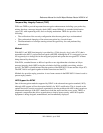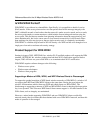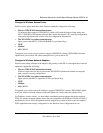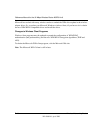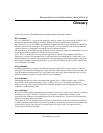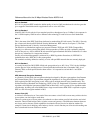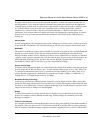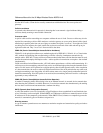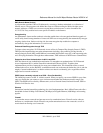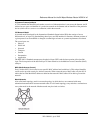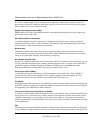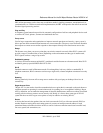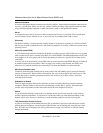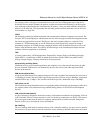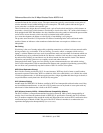
Reference Manual for the 54 Mbps Wireless Router WGR614 v6
G lossary -5
202-10099-01, April 2005
DNS (Domain Name Service)
A program that translates URLs to IP addresses by accessing a database maintained on a collection of
Internet servers. The program works behind the scenes to facilitate surfing the Web with alpha versus
numeric addresses. A DNS server converts a name like mywebsite.com to a series of numbers like
107.22.55.26. Every website has its own specific IP address on the Internet.
Encryption Key
An alphanumeric (letters and/or numbers) series that enables data to be encrypted and then decrypted so it
can be safely shared among members of a network. WEP uses an encryption key that automatically encrypts
outgoing wireless data. On the receiving side, the same encryption key enables the computer to
automatically decrypt the information so it can be read.
Enhanced Data Encryption through TKIP
To improve data encryption, Wi-Fi Protected Access utilizes its Temporal Key Integrity Protocol (TKIP).
TKIP provides important data encryption enhancements including a per-packet key mixing function, a
message integrity check (MIC) named Michael, an extended initialization vector (IV) with sequencing rules,
and a re-keying mechanism. Through these enhancements, TKIP addresses all WEP known vulnerabilities.
Enterprise-level User Authentication via 802.1x and EAP
WEP has almost no user authentication mechanism. To strengthen user authentication, Wi-Fi Protected
Access implements 802.1x and the Extensible Authentication Protocol (EAP). Together, these
implementations provide a framework for strong user authentication. This framework utilizes a central
authentication server, such as RADIUS, to authenticate each user on the network before they join it, and also
employs "mutual authentication" so that the wireless user doesn’t accidentally join a rogue network that
might steal its network credentials.
ESSID (more commonly referred to as SSID – Short Set Identifier)
The identifying name of an 802.11 wireless network. When you specify your correct ESSID in your client
setup you ensure that you connect to your wireless network rather than another network in range. (See
SSID.) The ESSID can be called by different terms, such as Network Name, Preferred Network, SSID or
Wireless LAN Service Area.
Ethernet
International standard networking technology for wired implementations. Basic 10BaseT networks offer a
bandwidth of about 10 Mbps. Fast Ethernet (100 Mbps) and Gigabit Ethernet (1000 Mbps) are becoming
popular.
Firewall
A system that secures a network and prevents access by unauthorized users. Firewalls can be software,
hardware or a combination of both. Firewalls can prevent unrestricted access into a network, as well as
restrict data from flowing out of a network.



